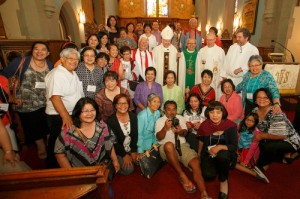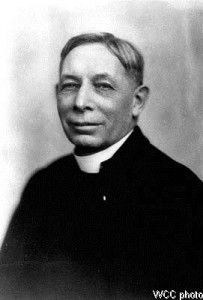
By Stuart Mann
Dr. John Alipit’s pilgrimage came to an emotional end inside St. George, Newcastle.
Dr. Alipit, born and raised in the Philippines and now living in Michigan, came to St. George’s in early August to pay homage to the man who had converted his parents to Christianity and provided him with an education that changed the course of his life.
“I practically shed tears when I first stepped into the church,” he said.
Dr. Alipit, a retired surgeon, was with a group of about 200 former students of St. Mary’s School in Sagada, a region in the northern Philippines. They had come to Newcastle to pay their respects to Bishop Charles Henry Brent, a child of the parish who had gone on to an illustrious career but is unknown to many Canadian Anglicans.
“I don’t think that there is any question that Bishop Brent was one of the best shepherds you would ever know,” said Dr. Alipit. “This is a spiritual journey for us, and now at last we are reconnected with Bishop Brent.”
In 1903, Bishop Brent, then a missionary bishop for The Episcopal Church of the United States, explored the area where Sagada is located and vowed not only to bring Christianity to the inhabitants but to provide education for them.
“Our area used to be a pagan, head-hunting region,” said Andrew Bacdayan, the president of St. Mary’s School. “Bishop Brent came and expressed his love for our people and worked very hard for our benefit.”

In 1904, Bishop Brent sent the Rev. John Staunton, an Episcopal priest from New York, to start a mission in Sagada. He provided schooling to the local children, and in 1912 St. Mary’s School was built. Over the years, the school developed a reputation for academic excellence.
“St. Mary’s School was one of the best in the Philippines, and we owe what we have to the type of education we got there,” said Dr. Alipit.
In the 1990s, the school was facing a financial shortfall, and by 2000 it was on the verge of closing. Alumni and their friends rallied to the school’s defence and put it on a sound financial footing.
Since 2005, alumni have been meeting every two years to raise funds for scholarships and school improvements. This year it was held in Toronto. “We chose Toronto not only because it is the area where Bishop Brent was born, bred and educated, but also for a special reason,” said Mr. Bacdayan. “We are a grateful people, and it is fitting that we, as alumni and friends of the school his bishopric founded, come to express our gratitude to his people.”
For many alumni, the highlight of the conference was the trip to St. George’s. They attended a special worship service that ended with rousing school songs, tears and hugs. The Rev. Eugene Berlenbach, the priest-in-charge of St. George’s, worked for a year to put it on.
“It was awesome, I cannot describe it,” said Rose Nabert, wiping away tears. “Here you are at the place where the person who came to you and brought the Christ to you lived. It’s overwhelming.”

Ms. Nabert graduated from St. Mary’s School in 1962. She went to a nursing school in the Philippines, then to a nursing school in Rochester, NY, as an exchange student. After a few years back in the Philippines, she attended Cornell University and then came to Canada. She lives in Toronto and is a member of St. Bartholomew, Regent Park.
“It feels like we’ve come full circle,” she said. “I know I wouldn’t be here without the missionaries. I never would have been a Christian. Our community in Sagada revolved around the school and the church. They were one. I don’t think I would have lasted away from home (in Rochester) without the church. It was very caring.”
The service at St. George was celebrated by Archbishop Terence Finlay, with assistance from Bishop Michael Bedford-Jones and Bishop Benjamin Botengan of the Central Diocese of the Philippines. After the service, everyone enjoyed music and dancing outside and a lunch in the parish hall.

Who was Bishop Charles Henry Brent?
Bishop Charles Henry Brent was one of the most influential clerics of the late 19th and early 20th centuries. He is commemorated in the liturgical calendars of both the Anglican Church of Canada and The Episcopal Church of the United States. His feast day is March 27 (BAS p. 24).
Born in Newcastle, Ontario, in 1862, Bishop Brent attended Trinity College School in Port Hope where one of the residential houses is named after him. He graduated from Trinity College, Toronto, and was ordained deacon and priest by the Bishop of Toronto. He took a parish in Buffalo, then tested his vocation at the Society of St. John the Evangelist in Cambridge Mass., but subsequently withdrew to take on parish work in one of the poorest sections of Boston.
In 1901, he was elected first missionary bishop of the Philippines, which at that time was a new territory acquired by the United States at the conclusion of the 1898 Spanish-American War. In Manila, he was pastor to Americans in both the government and private sectors. Being a personal friend of the territory’s first civil governor, Governor William Howard Taft, he became an unofficial adviser to the colonial government. Most importantly, from the point of view of the marginalized non-Christian tribes in both the northern and southern parts of the colony, he was a prodigious builder of churches, hospitals and schools. St. Mary’s School in Sagada in the northern Philippines was built during his episcopate.
After departing Manila in 1917 to spend a year as Senior Headquarters Chaplain of the American Expeditionary Forces in Europe during the First World War, he returned to the U.S. to become Bishop of the Diocese of Western New York in 1918. At that time, he was already an internationally recognized figure, and later would appear on the cover of Time magazine.
Bishop Brent’s international recognition stemmed from his work in two areas. First, he strongly advocated the regulation of opium use which the American colonial authorities then considered to be a serious problem facing Philippine society. As a testament to his leadership in this area, he was asked by the United States government to preside at the International Opium Conference in Shanghai in 1909, and later to head up the American delegations to the international opium conferences held at The Hague, Netherlands in 1911 and 1912.

Second, he was also a strong advocate for world church unity, now known as ecumenism. In both his bishoprics in the Philippines and the Diocese of Western New York, he unrelentingly pushed for ecumenism, a personal crusade that began to bear fruit when he became the unanimous choice for president of the First World Conference on Faith and Order, which met on Aug. 3, 1927, in Lausanne, Switzerland. On March 27, 1929, while on a return visit to Lausanne, he died and remains buried there. He was 66. His granite grave marker has an eloquent Celtic cross carved on its top. His obituary in the Manchester Guardian said, “He could speak to businessmen or diplomats or undergraduates with equal ease, and all knew that a man of God had been among us.”
Due to the interruptions created by the Second World War, the meeting he presided at in 1927 finally culminated in the founding in 1948 of the World Council of Churches in Geneva, Switzerland. To some of his biographers, this was the crowning glory of his distinguished career.
Information for this article was supplied by Bishop Michael Bedford-Jones (retired) of the Diocese of Toronto and Andrew Bacdayan, president and board chair of St. Mary’s School of Sagada Alumni and Friends Foundation.